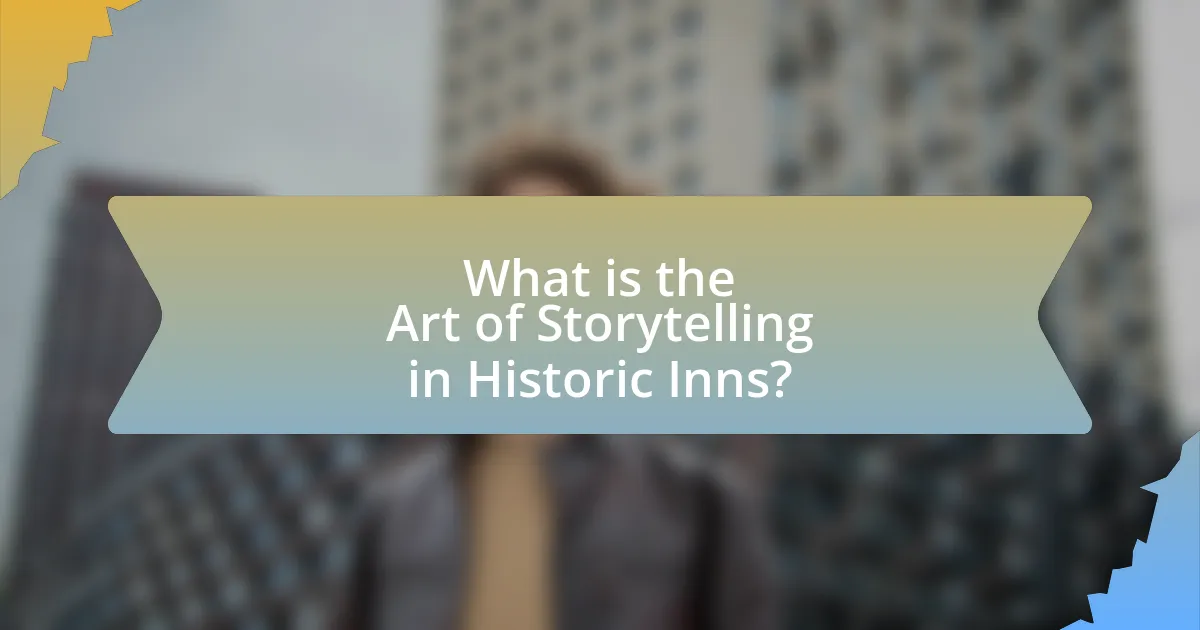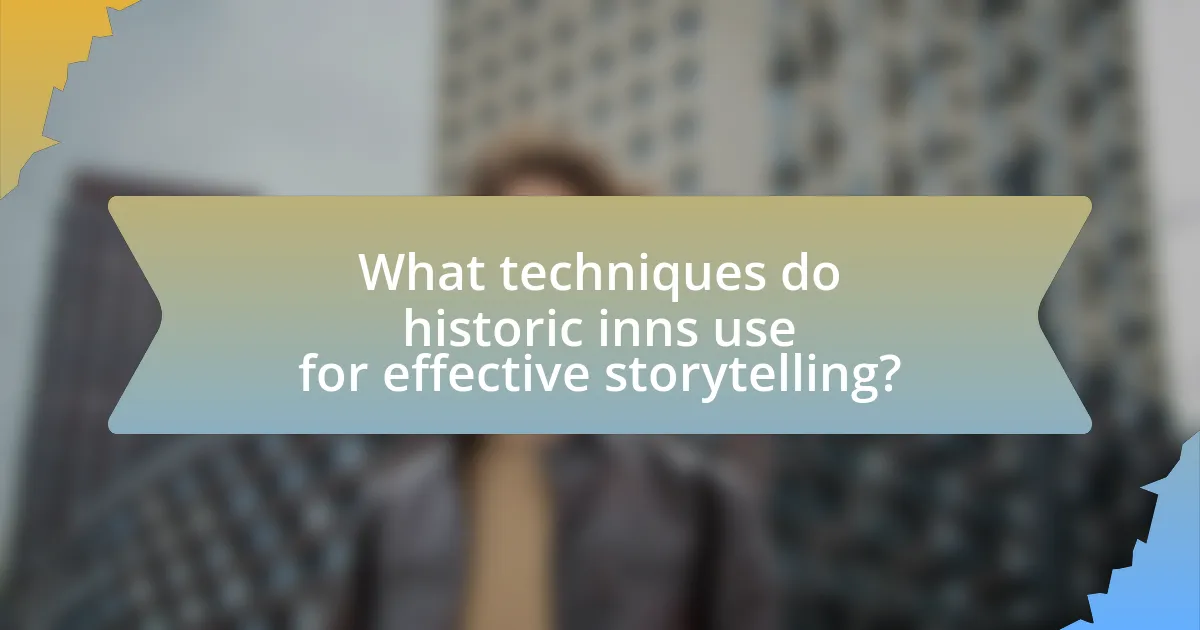The main entity of the article is the art of storytelling in historic inns, which serves to preserve and share local legends and historical narratives that enhance guest experiences. The article explores how historic inns utilize storytelling to engage guests through guided tours, personal anecdotes, and themed events, highlighting the types of stories commonly shared, such as ghost tales and local folklore. It discusses the importance of storytelling in connecting guests to local culture and history, the techniques used for effective storytelling, and the challenges faced by innkeepers in balancing authenticity with entertainment. Additionally, the article examines how local legends shape the identity of historic inns and influence tourism, while also providing insights into best practices for developing storytelling programs and training staff.

What is the Art of Storytelling in Historic Inns?
The art of storytelling in historic inns involves the preservation and sharing of local legends and historical narratives that enhance the guest experience. Historic inns often serve as repositories of regional history, where tales of past events, notable figures, and cultural traditions are recounted through guided tours, written materials, and personal anecdotes from innkeepers. For instance, many historic inns have been in operation for centuries, allowing them to accumulate rich stories that reflect the community’s heritage, such as the tales of Revolutionary War soldiers or local folklore. This storytelling not only engages guests but also fosters a deeper connection to the locale, making the experience memorable and educational.
How do historic inns utilize storytelling to engage guests?
Historic inns utilize storytelling to engage guests by sharing local legends and historical narratives that enhance the guest experience. These establishments often incorporate tales of their own history, notable past guests, and regional folklore into guided tours, informational materials, and themed events. For example, many historic inns may recount the stories of famous figures who stayed there or significant events that took place on the premises, creating a deeper connection between the guests and the location. This approach not only entertains but also educates guests about the cultural heritage of the area, fostering a memorable stay that resonates with the unique character of the inn.
What types of stories are commonly shared in historic inns?
Historic inns commonly share ghost stories, local legends, and historical anecdotes. Ghost stories often involve tales of hauntings or unexplained phenomena linked to the inn’s past, captivating guests with eerie experiences. Local legends typically highlight significant events or notable figures associated with the area, enriching the cultural narrative of the inn. Historical anecdotes provide insights into the inn’s role in local history, such as its use during important events or its connection to famous visitors, thereby enhancing the guest experience with a sense of place and time.
How do these stories reflect local culture and history?
These stories reflect local culture and history by preserving and conveying the unique traditions, values, and events that shape a community’s identity. For instance, tales shared in historic inns often highlight significant local figures, pivotal historical events, or cultural practices that have been passed down through generations. This oral tradition not only entertains but also educates visitors about the region’s heritage, fostering a deeper understanding of its social fabric. Specific examples include legends surrounding local heroes or folklore that illustrate the community’s resilience and character, thereby reinforcing the connection between the past and present.
Why is storytelling important in the context of historic inns?
Storytelling is important in the context of historic inns because it enhances the guest experience by connecting them to the rich history and local culture of the area. Historic inns often have unique narratives tied to their architecture, previous occupants, and significant events, which can create a deeper emotional engagement for visitors. For instance, inns that share tales of famous guests or local legends can foster a sense of place and belonging, making the stay more memorable. This practice not only preserves local heritage but also promotes tourism, as guests are drawn to the stories that make each inn distinctive.
What role does storytelling play in preserving local legends?
Storytelling plays a crucial role in preserving local legends by serving as a medium for cultural transmission and community identity. Through oral traditions, stories are passed down generations, ensuring that the unique narratives of a community remain alive and relevant. For instance, research indicates that oral storytelling can enhance memory retention and cultural continuity, as seen in various indigenous cultures where legends are integral to their heritage. This method not only keeps the legends intact but also fosters a sense of belonging among community members, reinforcing shared values and history.
How does storytelling enhance the guest experience?
Storytelling enhances the guest experience by creating emotional connections and immersive environments that engage visitors. When historic inns share local legends, they provide context and meaning to the surroundings, allowing guests to feel a deeper connection to the place. Research indicates that storytelling can increase guest satisfaction by up to 30%, as it transforms a simple stay into a memorable experience filled with cultural significance. This engagement not only enriches the visit but also fosters a sense of belonging and appreciation for the local heritage.

What techniques do historic inns use for effective storytelling?
Historic inns use immersive experiences, personal narratives, and historical artifacts for effective storytelling. Immersive experiences engage guests through themed decor and guided tours that highlight the inn’s history and local legends. Personal narratives, often shared by staff or through written materials, connect visitors to the stories of past guests or significant events that occurred at the inn. Historical artifacts, such as photographs, furniture, and documents, provide tangible links to the past, enhancing the authenticity of the storytelling. These techniques collectively create a rich narrative environment that captivates guests and fosters a deeper appreciation for the inn’s heritage.
How do innkeepers craft compelling narratives?
Innkeepers craft compelling narratives by integrating local history, personal anecdotes, and unique experiences into their storytelling. They often research the historical significance of their inns and the surrounding area, allowing them to weave authentic tales that resonate with guests. For example, many historic inns highlight notable past events or famous figures associated with their location, creating a rich context that enhances the guest experience. This approach not only captivates visitors but also fosters a deeper connection to the locale, making the stay memorable and engaging.
What elements make a story memorable in a historic setting?
Compelling characters, authentic historical context, and emotional resonance make a story memorable in a historic setting. Compelling characters engage the audience by embodying the struggles and triumphs of their time, allowing readers to connect on a personal level. Authentic historical context grounds the narrative in real events, enhancing credibility and immersing the audience in the era’s atmosphere. Emotional resonance, achieved through relatable themes and experiences, ensures that the story lingers in the minds of the audience. For instance, stories set during significant events like the American Revolution or the Civil Rights Movement often evoke strong emotions and reflections on human resilience, making them particularly memorable.
How do visual aids and ambiance contribute to storytelling?
Visual aids and ambiance significantly enhance storytelling by creating immersive experiences that engage the audience’s senses and emotions. Visual aids, such as photographs, artifacts, and illustrations, provide tangible connections to the narrative, making historical events and local legends more relatable and vivid. For instance, in historic inns, the presence of period-specific decor and artifacts can transport guests to the time and place of the story being told, reinforcing the authenticity of the narrative. Research indicates that environments rich in sensory stimuli can improve memory retention and emotional engagement, which are crucial for effective storytelling. Therefore, the combination of visual aids and a carefully curated ambiance not only captivates the audience but also deepens their understanding and appreciation of the stories being shared.
What are the challenges faced in storytelling at historic inns?
The challenges faced in storytelling at historic inns include maintaining historical accuracy, engaging diverse audiences, and preserving the integrity of local legends. Historic inns often struggle with the need to balance factual representation of events with the embellishments that make stories captivating. For instance, while some guests may seek authentic historical narratives, others may prefer more entertaining, dramatized versions of local lore. Additionally, the varying interests and backgrounds of visitors can complicate the storytelling approach, as what resonates with one group may not appeal to another. Furthermore, the physical setting of historic inns, which may have limitations in terms of space and resources for storytelling presentations, can hinder the effective delivery of these narratives.
How do innkeepers balance authenticity with entertainment?
Innkeepers balance authenticity with entertainment by integrating local history and culture into engaging narratives that captivate guests. They achieve this by crafting stories that reflect the unique heritage of their inns while incorporating interactive elements, such as themed events or guided tours. For instance, many historic inns offer storytelling sessions that highlight local legends, allowing guests to experience the area’s history in an entertaining format. This approach not only preserves the authenticity of the inn’s character but also enhances the guest experience, making it memorable and immersive.
What strategies can be employed to overcome storytelling challenges?
To overcome storytelling challenges, one effective strategy is to engage the audience through interactive elements, such as questions or prompts that invite participation. This approach fosters a connection between the storyteller and the audience, enhancing the overall experience. Research indicates that interactive storytelling can increase retention and emotional engagement, as evidenced by a study published in the Journal of Interactive Media, which found that audiences are 30% more likely to remember stories that involve active participation. Additionally, utilizing vivid imagery and sensory details can help create a more immersive narrative, making it easier for listeners to visualize and connect with the story being told.

How do local legends influence the identity of historic inns?
Local legends significantly shape the identity of historic inns by creating a unique narrative that attracts visitors and fosters a sense of place. These legends often stem from the inn’s history, local culture, or notable events, which imbue the establishment with character and intrigue. For instance, an inn that is rumored to be haunted may promote ghost tours or themed events, enhancing its appeal and encouraging storytelling among guests. This connection to local lore not only differentiates the inn from competitors but also cultivates a community identity, as locals take pride in sharing their heritage with visitors. The intertwining of local legends with the inn’s branding and marketing strategies further solidifies its identity, making it a memorable destination.
What are some famous local legends associated with historic inns?
Famous local legends associated with historic inns include the tale of the Ghost of the White Eagle Inn in New York, where patrons report sightings of a spectral figure believed to be a former innkeeper. Another notable legend is the story of the Haunted Bell Inn in England, which is said to be haunted by a woman who was wronged in love, leading to mysterious occurrences. Additionally, the Old Talbott Tavern in Kentucky is known for its ghostly visitors, including a soldier from the Revolutionary War, as documented in local folklore. These legends enhance the cultural significance of these inns, attracting visitors intrigued by their storied pasts.
How do these legends shape the branding of the inns?
Legends shape the branding of inns by creating a unique narrative that enhances their identity and appeal. These stories often highlight the historical significance of the inns, attracting visitors interested in local culture and heritage. For instance, an inn associated with a famous local legend can market itself as a destination for those seeking an authentic experience, thereby differentiating itself from competitors. This branding strategy is supported by research indicating that storytelling can increase customer engagement and loyalty, as guests are drawn to the emotional connections and experiences tied to the legends.
What impact do local legends have on tourism in the area?
Local legends significantly enhance tourism in an area by attracting visitors who seek unique cultural experiences. These legends often create a sense of intrigue and connection to the local history, encouraging tourists to explore the region’s attractions, such as historic inns that share these stories. For instance, a study by the University of Florida found that destinations with rich folklore and storytelling traditions see a 20% increase in visitor engagement compared to those without such narratives. This engagement translates into higher occupancy rates in local accommodations and increased spending in the community, demonstrating the economic benefits of leveraging local legends for tourism.
How can guests participate in the storytelling experience?
Guests can participate in the storytelling experience by engaging in interactive sessions led by storytellers at historic inns. These sessions often invite guests to share their own stories or ask questions, fostering a collaborative atmosphere. Additionally, guests may be encouraged to explore the inn’s surroundings, which can serve as inspiration for storytelling, thereby deepening their connection to local legends. This participatory approach enhances the overall experience, making it more immersive and memorable.
What activities encourage guest involvement in storytelling?
Activities that encourage guest involvement in storytelling include interactive workshops, guided storytelling sessions, and themed events that invite participation. Interactive workshops allow guests to create their own narratives, fostering a personal connection to the stories being told. Guided storytelling sessions often involve guests sharing their own experiences, which enhances engagement and creates a communal atmosphere. Themed events, such as historical reenactments or local folklore nights, encourage guests to immerse themselves in the storytelling process, making it a shared experience. These activities not only enhance guest involvement but also enrich the overall storytelling experience by blending personal narratives with local legends.
How can guests share their own stories during their stay?
Guests can share their own stories during their stay by participating in designated storytelling sessions organized by the inn. These sessions often encourage guests to recount personal experiences related to the local history or legends, fostering a communal atmosphere. Many historic inns provide a comfortable setting, such as a cozy lounge or a fire pit, where guests can gather and share their narratives. This practice not only enhances the guest experience but also contributes to the preservation of local lore, as stories are exchanged and recorded for future visitors.
What best practices can historic inns adopt for storytelling?
Historic inns can adopt several best practices for storytelling, including integrating local history into their narratives, utilizing immersive experiences, and engaging guests through interactive storytelling methods. By weaving local legends and historical events into their guest experiences, inns can create a unique atmosphere that resonates with visitors. For instance, providing guided tours that highlight significant historical events or figures associated with the inn can enhance the storytelling experience. Additionally, incorporating elements such as themed decor, period-appropriate furnishings, and storytelling sessions led by knowledgeable staff can further immerse guests in the narrative. Research indicates that experiential storytelling significantly enhances guest satisfaction and retention, as it fosters a deeper emotional connection to the location and its history.
How can inns train staff to enhance storytelling skills?
Inns can train staff to enhance storytelling skills through structured workshops and role-playing exercises. These training sessions can focus on narrative techniques, character development, and engaging delivery methods. For instance, incorporating local history and legends into the training can provide staff with authentic material to work with, making their storytelling more relatable and impactful. Research indicates that experiential learning, such as practicing storytelling in front of peers, significantly improves communication skills and confidence. By regularly evaluating staff performance and providing constructive feedback, inns can ensure continuous improvement in storytelling abilities.
What resources are available for developing storytelling programs?
Resources available for developing storytelling programs include training workshops, online courses, and storytelling organizations. Training workshops, such as those offered by the National Storytelling Network, provide hands-on experience and techniques for effective storytelling. Online courses from platforms like Coursera and Udemy cover various aspects of storytelling, including narrative structure and audience engagement. Additionally, organizations like the Moth and StoryCorps offer resources, community support, and platforms for sharing stories, which can enhance the development of storytelling programs. These resources collectively support the creation and refinement of storytelling initiatives, particularly in contexts like historic inns that aim to share local legends.